Poole Ch.P., Jr. Handbook of Superconductivity
Подождите немного. Документ загружается.

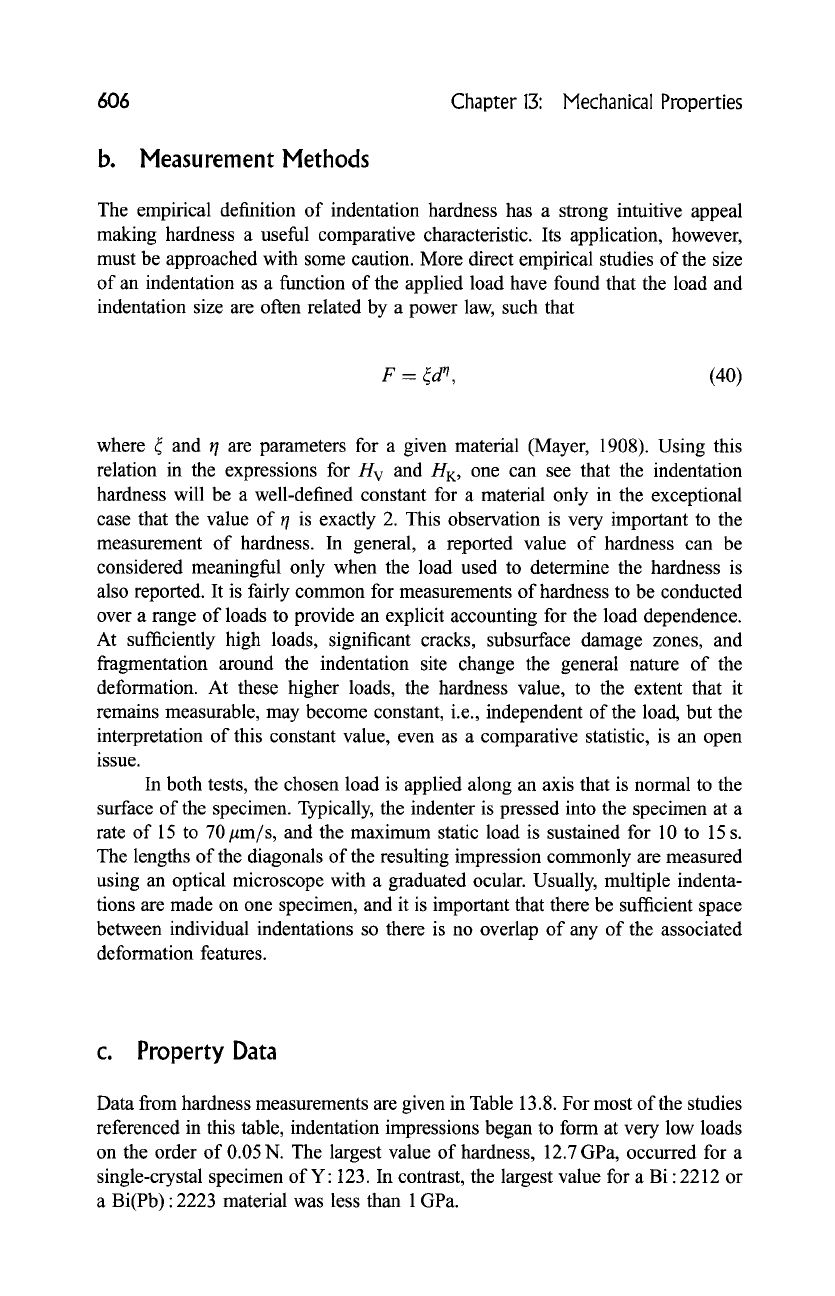
606 Chapter 13: Mechanical Properties
b. Measurement Methods
The empirical definition of indentation hardness has a strong intuitive appeal
making hardness a useful comparative characteristic. Its application, however,
must be approached with some caution. More direct empirical studies of the size
of an indentation as a function of the applied load have found that the load and
indentation size are often related by a power law, such that
F = ~d '7, (40)
where ~ and r/ are parameters for a given material (Mayer, 1908). Using this
relation in the expressions for H v and HK, one can see that the indentation
hardness will be a well-defined constant for a material only in the exceptional
case that the value of r/ is exactly 2. This observation is very important to the
measurement of hardness. In general, a reported value of hardness can be
considered meaningful only when the load used to determine the hardness is
also reported. It is fairly common for measurements of hardness to be conducted
over a range of loads to provide an explicit accounting for the load dependence.
At sufficiently high loads, significant cracks, subsurface damage zones, and
fragmentation around the indentation site change the general nature of the
deformation. At these higher loads, the hardness value, to the extent that it
remains measurable, may become constant, i.e., independent of the load, but the
interpretation of this constant value, even as a comparative statistic, is an open
issue.
In both tests, the chosen load is applied along an axis that is normal to the
surface of the specimen. Typically, the indenter is pressed into the specimen at a
rate of 15 to 70 #m/s, and the maximum static load is sustained for 10 to 15 s.
The lengths of the diagonals of the resulting impression commonly are measured
using an optical microscope with a graduated ocular. Usually, multiple indenta-
tions are made on one specimen, and it is important that there be sufficient space
between individual indentations so there is no overlap of any of the associated
deformation features.
c. Property Data
Data from hardness measurements are given in Table 13.8. For most of the studies
referenced in this table, indentation impressions began to form at very low loads
on the order of 0.05N. The largest value of hardness, 12.7 GPa, occurred for a
single-crystal specimen of Y: 123. In contrast, the largest value for a Bi : 2212 or
a Bi(Pb) : 2223 material was less than 1 GPa.
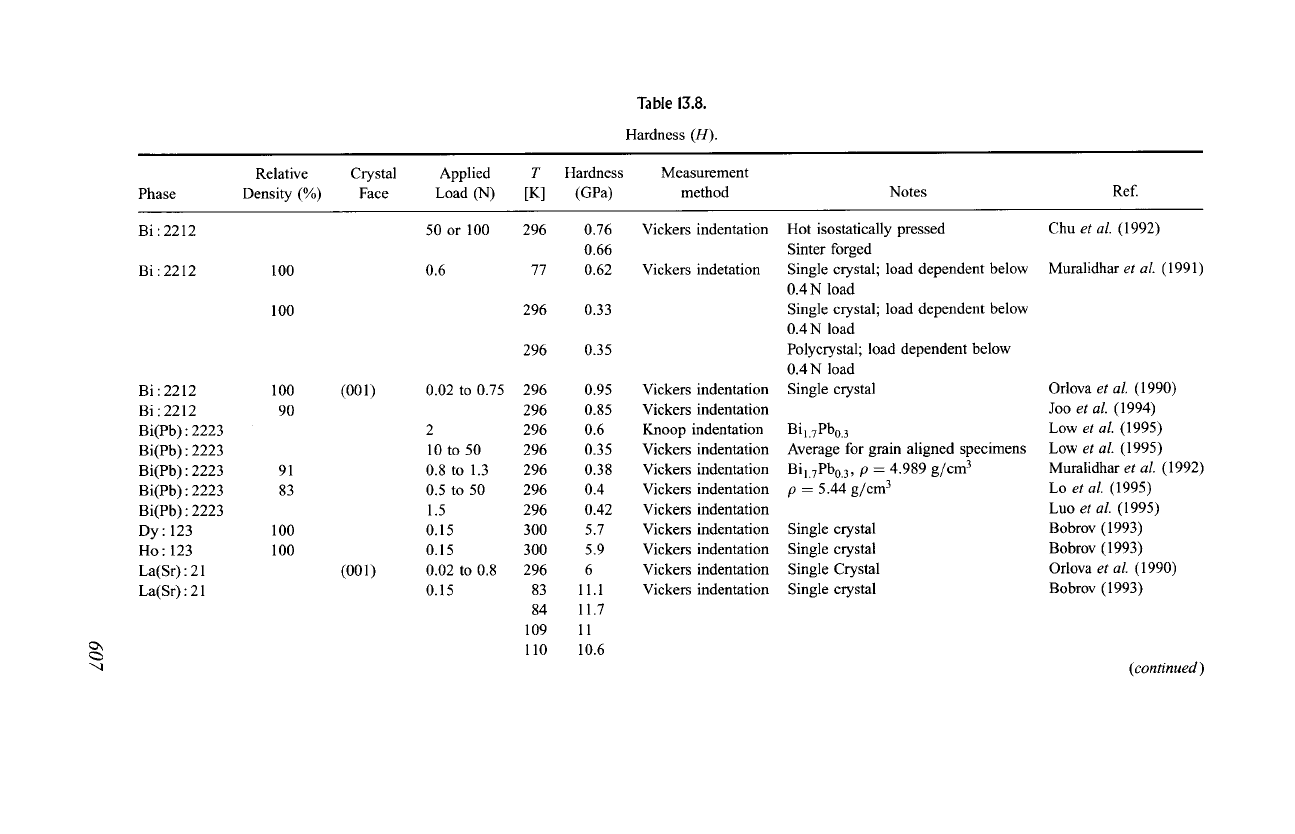
Table 13.8.
Hardness (H).
Phase
Relative Crystal
Density (%) Face
Applied T Hardness
Load (N) [K] (GPa)
Measurement
method Notes Ref.
,,q
Bi:2212
Bi:2212
Bi:2212
Bi:2212
Bi(Pb) : 2223
Bi(Pb) : 2223
Bi(Pb) : 2223
Bi(Pb) : 2223
Bi(Pb) : 2223
Dy: 123
Ho: 123
La(Sr) : 21
La(Sr) : 21
100
100
100 (001)
9O
91
83
100
100
(001)
50 or 100 296 0.76
0.66
0.6 77 0.62
296 0.33
296 0.35
0.02 to 0.75 296 0.95
296 0.85
2 296 0.6
10 to 50 296 0.35
0.8 to 1.3 296 0.38
0.5 to 50 296 0.4
1.5 296 0.42
0.15 300 5.7
0.15 300 5.9
0.02 to 0.8 296 6
0.15 83 11.1
84 11.7
109 11
110 10.6
Vickers indentation Hot isostatically pressed
Sinter forged
Vickers indetation
Vickers indentation
Vickers indentation
Knoop indentation
Chu
et al.
(1992)
Single crystal; load dependent below Muralidhar
et al.
(1991)
0.4 N load
Single crystal; load dependent below
0.4 N load
Polycrystal; load dependent below
0.4 N load
Single crystal
Bil.7Pb0.3
Vickers indentation Average for grain aligned specimens
Vickers indentation Bil.7Pb0.3, p = 4.989 g/cm 3
Vickers indentation p = 5.44 g/cm 3
Vickers indentation
Vickers indentation Single crystal
Vickers indentation Single crystal
Vickers indentation Single Crystal
Vickers indentation Single crystal
Orlova
et aL
(1990)
Joo
et aL
(1994)
Low
et aL
(1995)
Low
et aL
(1995)
Muralidhar
et al.
(1992)
Lo
et al.
(1995)
Luo
et aL
(1995)
Bobrov (1993)
Bobrov (1993)
Orlova
et al.
(1990)
Bobrov (1993)
(continued)
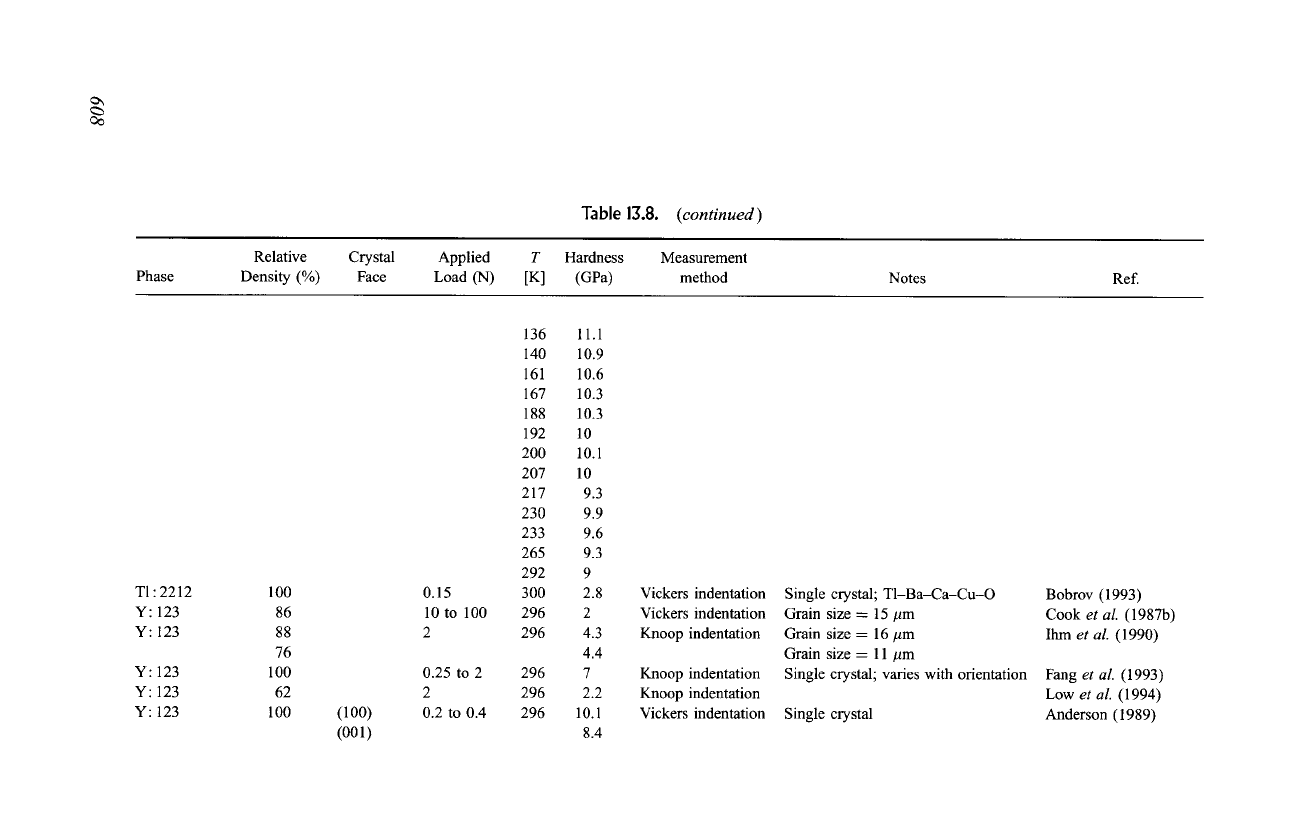
Table 13.8.
(continued)
Phase
Relative Crystal
Density (%) Face
Applied T Hardness
Load (N) [K] (GPa)
Measurement
method Notes Ref.
T1:2212
Y: 123
Y: 123
Y: 123
Y: 123
Y: 123
100
86
88
76
100
62
100
(100)
(001)
0.15
10 to 100
2
0.25 to 2
2
0.2 to 0.4
136 11.1
140 10.9
161 10.6
167 10.3
188 10.3
192 10
200 10.1
207 10
217 9.3
230 9.9
233 9.6
265 9.3
292 9
300 2.8
296 2
296 4.3
4.4
296 7
296 2.2
296 10.1
8.4
Vickers indentation Single crystal; T1-Ba-Ca-Cu-O Bobrov (1993)
Vickers indentation Grain size -- 15 #m Cook
et aL (1987b)
Knoop indentation Grain size = 16 #m Ihm
et aL (1990)
Grain size- 11/~m
Knoop indentation Single crystal; varies with orientation Fang
et al.
(1993)
Knoop indentation Low
et al.
(1994)
Vickers indentation Single crystal Anderson (1989)
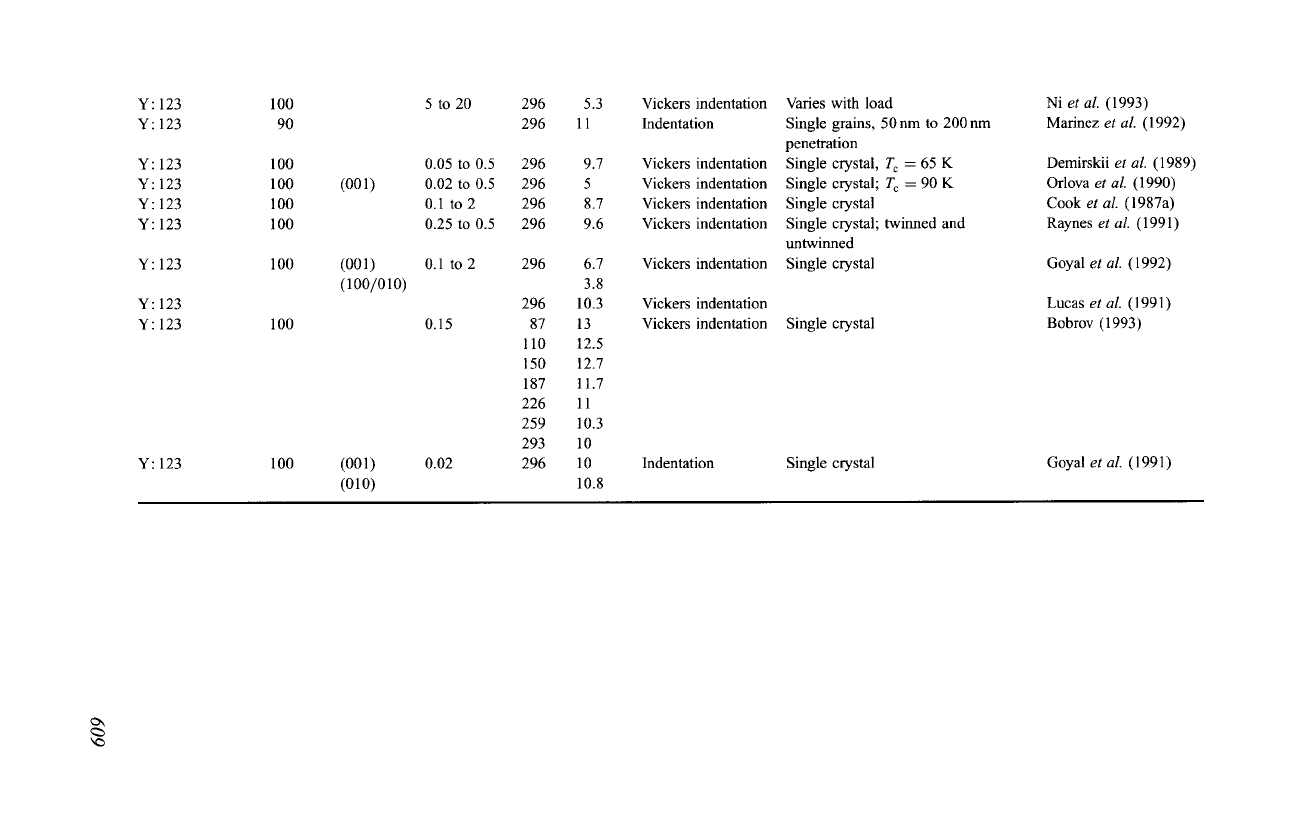
Y: 123
Y: 123
Y: 123
Y: 123
Y: 123
Y: 123
Y" 123
Y" 123
Y" 123
Y" 123
100
90
100
100
1
O0
1 O0
1 O0
100
100
(001)
(OOl)
(lOO/OlO)
(OOl)
(OLO)
5 to 20
0.05 to 0.5
0.02 to 0.5
0.1 to2
0.25 to 0.5
0.1 to2
0.15
0.02
296
296
296
296
296
296
296
296
87
110
150
187
226
259
293
296
5.3
11
9.7
5
8.7
9.6
6.7
3.8
10.3
13
12.5
12.7
11.7
11
10.3
10
10
10.8
Vickers indentation Varies with load
Indentation Single grains, 50 nm to 200 nm
penetration
Vickers indentation Single crystal, T c -- 65 K
Vickers indentation Single crystal; T c = 90 K
Vickers indentation Single crystal
Vickers indentation Single crystal; twinned and
untwinned
Vickers indentation Single crystal
Vickers indentation
Vickers indentation Single crystal
Indentation Single crystal
Ni
et al.
(1993)
Marinez
et al.
(1992)
Demirskii
et al.
(1989)
Orlova
et al.
(1990)
Cook
et al.
(1987a)
Raynes
et al.
(1991)
Goyal
et al.
(1992)
Lucas
et al.
(1991)
Bobrov (1993)
Goyal
et al.
(1991)
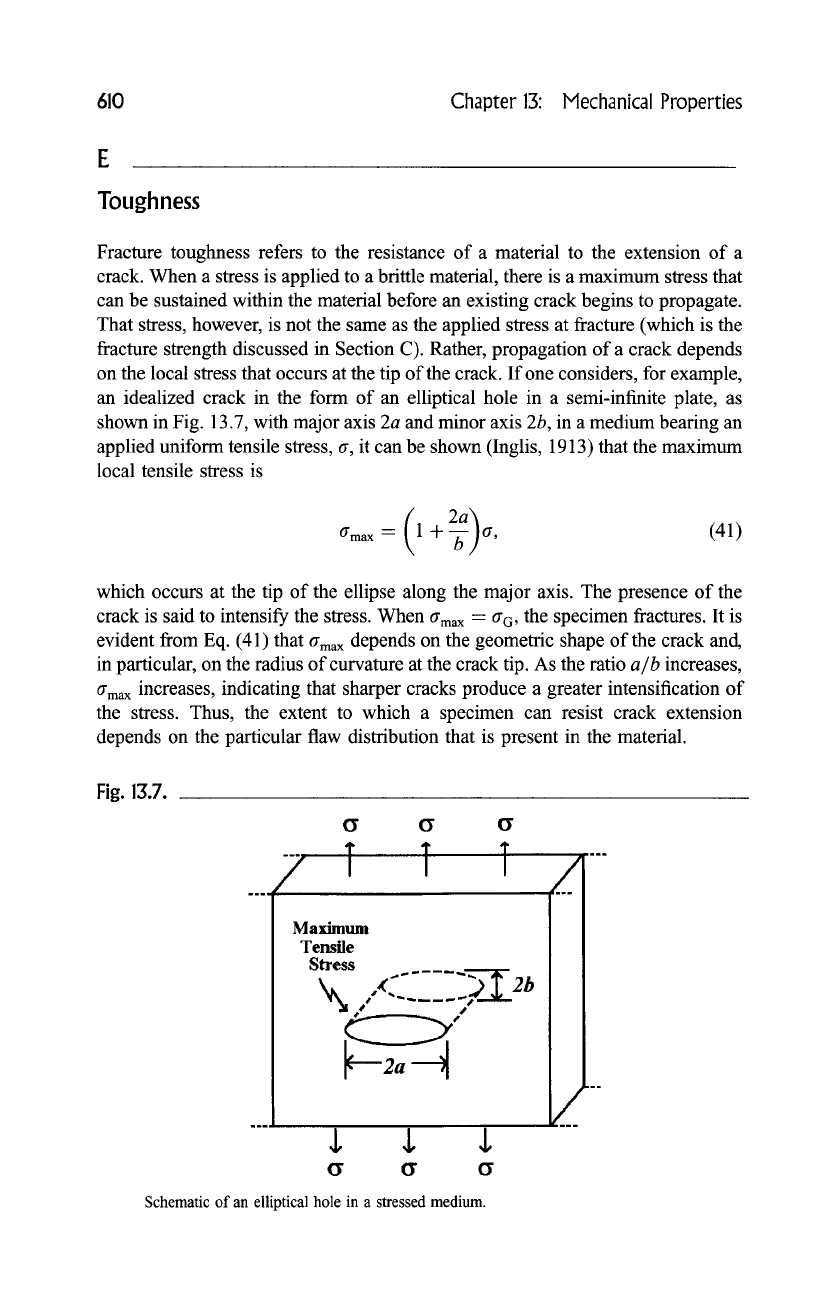
610 Chapter 13: Mechanical Properties
Toughness
Fracture toughness refers to the resistance of a material to the extension of a
crack. When a stress is applied to a brittle material, there is a maximum stress that
can be sustained within the material before an existing crack begins to propagate.
That stress, however, is not the same as the applied stress at fracture (which is the
fracture strength discussed in Section C). Rather, propagation of a crack depends
on the local stress that occurs at the tip of the crack. If one considers, for example,
an idealized crack in the form of an elliptical hole in a semi-infinite plate, as
shown in Fig. 13.7, with major axis 2a and minor axis 2b, in a medium beating an
applied uniform tensile stress, O-, it can be shown (Inglis, 1913) that the maximum
local tensile stress is
O-max -- (1 nt- b) O-, (41)
which occurs at the tip of the ellipse along the major axis. The presence of the
crack is said to intensify the stress. When amax -- O-a, the specimen fractures. It is
evident from Eq. (41) that O'ma x depends on the geometric shape of the crack and,
in particular, on the radius of curvature at the crack tip. As the ratio
a/b
increases,
O-max increases, indicating that sharper cracks produce a greater intensification of
the stress. Thus, the extent to which a specimen can resist crack extension
depends on the particular flaw distribution that is present in the material.
Fig. 13.7.
G G G
...)z
T T T
z'l"
Maximmn
Tensile
Stress
G (Y I~
Schematic of an elliptical hole in a stressed medium.
..=
Z
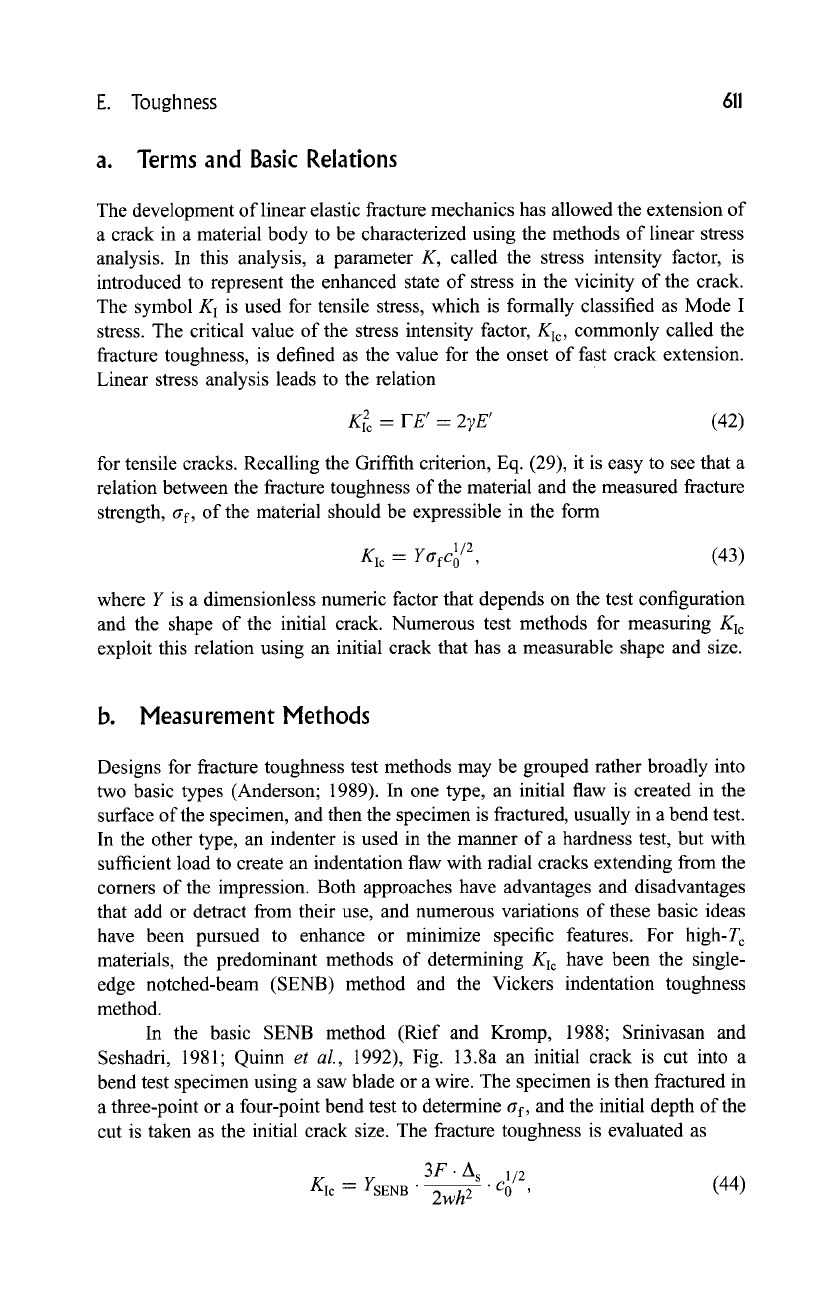
E. Toughness 611
a. Terms and Basic Relations
The development of linear elastic fracture mechanics has allowed the extension of
a crack in a material body to be characterized using the methods of linear stress
analysis. In this analysis, a parameter K, called the stress intensity factor, is
introduced to represent the enhanced state of stress in the vicinity of the crack9
The symbol K I is used for tensile stress, which is formally classified as Mode I
stress. The critical value of the stress intensity factor, Kic, commonly called the
fracture toughness, is defined as the value for the onset of fast crack extension.
Linear stress analysis leads to the relation
KZc = FE'= 27E' (42)
for tensile cracks. Recalling the Griffith criterion, Eq. (29), it is easy to see that a
relation between the fracture toughness of the material and the measured fracture
strength, af, of the material should be expressible in the form
KI c
.7
1/2
(43)
l~TfCo ,
where Y is a dimensionless numeric factor that depends on the test configuration
and the shape of the initial crack. Numerous test methods for measuring Kic
exploit this relation using an initial crack that has a measurable shape and size.
b. Measurement Methods
Designs for fracture toughness test methods may be grouped rather broadly into
two basic types (Anderson; 1989). In one type, an initial flaw is created in the
surface of the specimen, and then the specimen is fractured, usually in a bend test.
In the other type, an indenter is used in the manner of a hardness test, but with
sufficient load to create an indentation flaw with radial cracks extending from the
comers of the impression. Both approaches have advantages and disadvantages
that add or detract from their use, and numerous variations of these basic ideas
have been pursued to enhance or minimize specific features. For high-T c
materials, the predominant methods of determining Kic have been the single-
edge notched-beam (SENB) method and the Vickers indentation toughness
method.
In the basic SENB method (Rief and Kromp, 1988; Srinivasan and
Seshadri, 1981; Quinn
et al.,
1992), Fig. 13.8a an initial crack is cut into a
bend test specimen using a saw blade or a wire. The specimen is then fractured in
a three-point or a four-point bend test to determine o-f, and the initial depth of the
cut is taken as the initial crack size. The fracture toughness is evaluated as
3F-A s 1/2
9 c 0 , (44)
KIc- YSENB "
2wh2
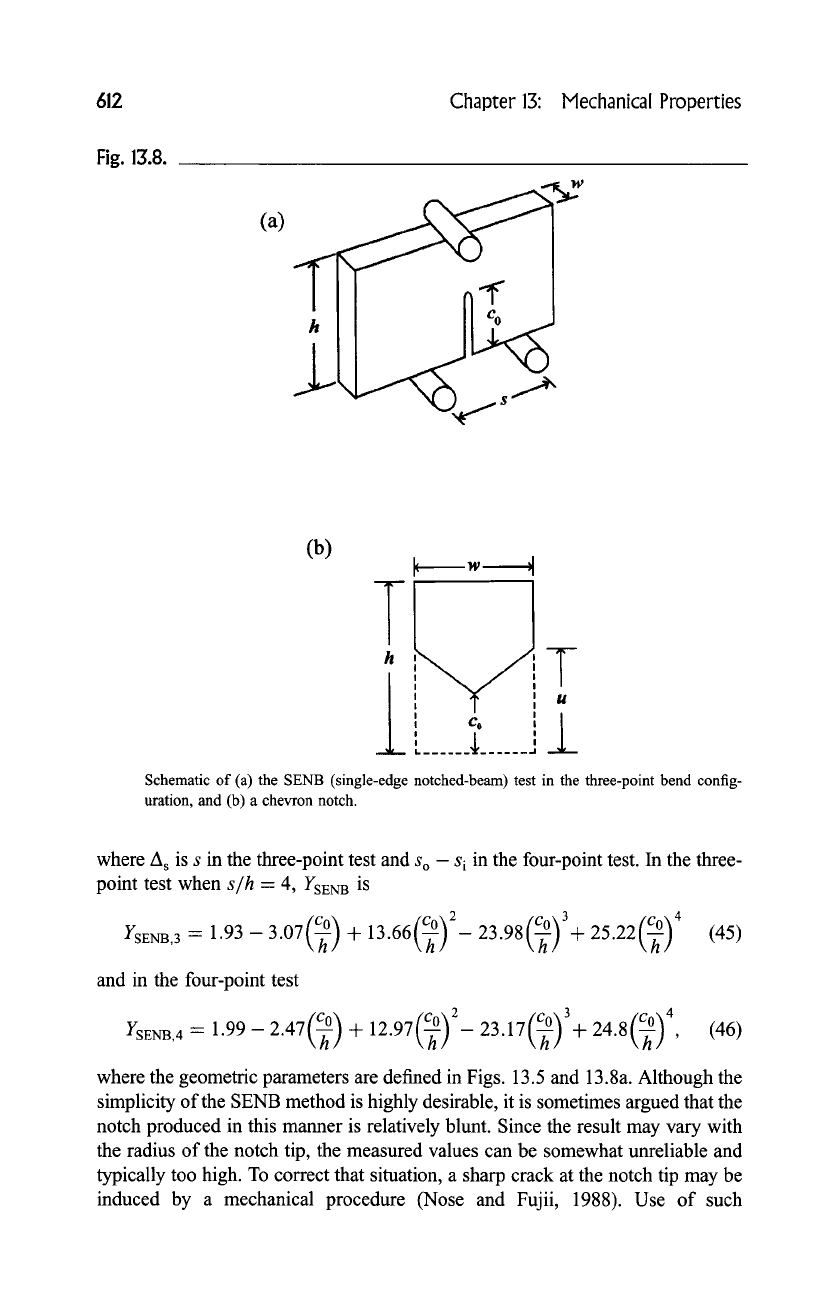
612 Chapter 13: Hechanicai Properties
Fig. 13.8.
(a)
W
) ..s -''~
,r
(b)
T
h
1
L W d
P 1
22T
i l
:"
co ',1
' _L I
I._ .......... ,,,1
Schematic of (a) the SENB (single-edge notched-beam) test in the three-point bend config-
uration, and (b) a chevron notch.
where A s is s in the three-point test and s o - s i in the four-point test. In the three-
point test when
s/h
= 4, YSENB is
(--~) (-'~) (h) 3 (h) 4
2
YSENB,3 = 1.93- 3.07 + 13.66 23.98 + 25.22
(45)
and in the four-point test
(h) (h) 2 (h)3 (h)4
YSENB,4 = 1.99 -- 2.47 + 12.97 23.17 + 24.8
(46)
where the geometric parameters are defined in Figs. 13.5 and 13.8a. Although the
simplicity of the SENB method is highly desirable, it is sometimes argued that the
notch produced in this manner is relatively blunt. Since the result may vary with
the radius of the notch tip, the measured values can be somewhat unreliable and
typically too high. To correct that situation, a sharp crack at the notch tip may be
induced by a mechanical procedure (Nose and Fujii, 1988). Use of such
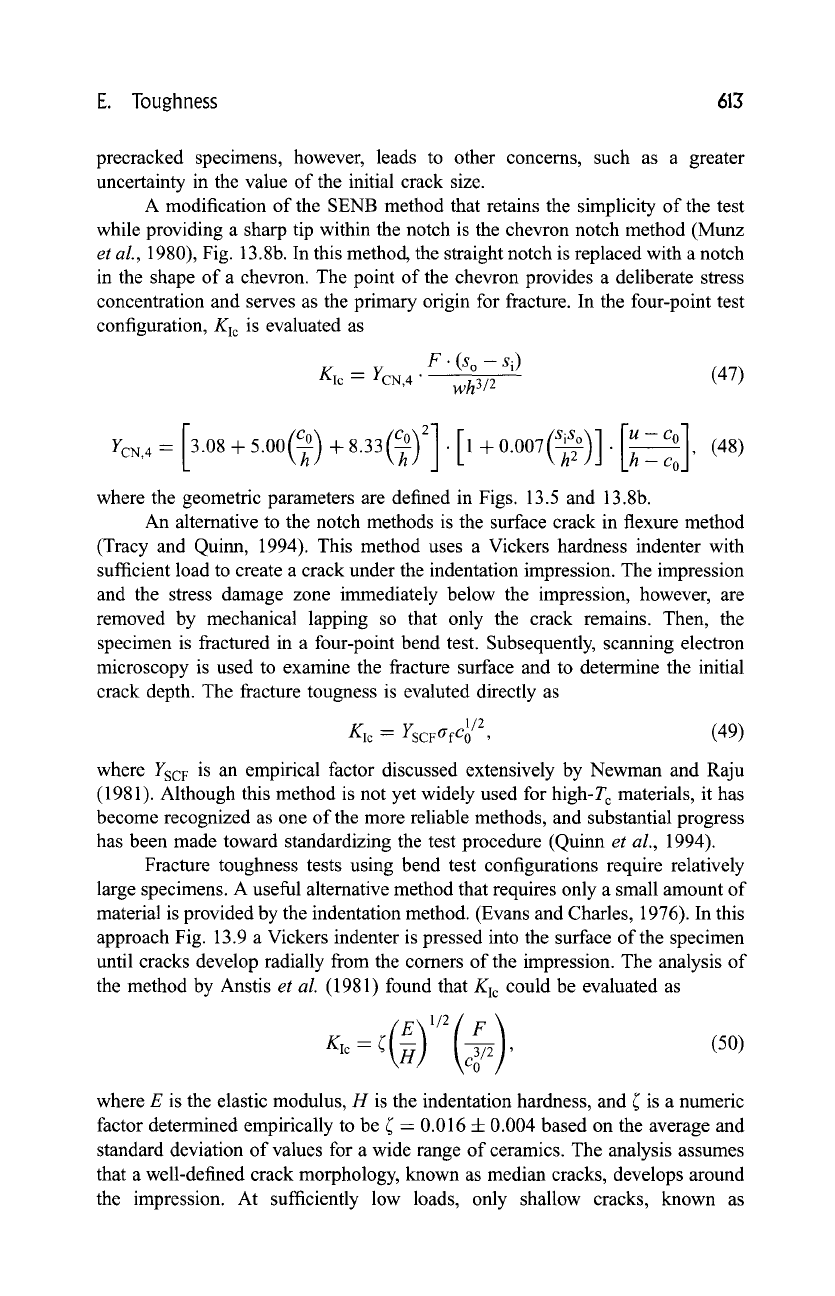
E. Toughness 613
precracked specimens, however, leads to other concerns, such as a greater
uncertainty in the value of the initial crack size.
A modification of the SENB method that retains the simplicity of the test
while providing a sharp tip within the notch is the chevron notch method (Munz
et al.,
1980), Fig. 13.8b. In this method, the straight notch is replaced with a notch
in the shape of a chevron. The point of the chevron provides a deliberate stress
concentration and serves as the primary origin for fracture. In the four-point test
configuration, Kic is evaluated as
F. (s o - Si)
KIc- YEN,4 "
wh3/2
(47)
YCN,4-
3.08 + 5.00(-~)+ 8.33(h) 2 9 [1 + 0.007\ h2 ,/]. Co,
where the geometric parameters are defined in Figs. 13.5 and 13.8b.
An alternative to the notch methods is the surface crack in flexure method
(Tracy and Quinn, 1994). This method uses a Vickers hardness indenter with
sufficient load to create a crack under the indentation impression. The impression
and the stress damage zone immediately below the impression, however, are
removed by mechanical lapping so that only the crack remains. Then, the
specimen is fractured in a four-point bend test. Subsequently, scanning electron
microscopy is used to examine the fracture surface and to determine the initial
crack depth. The fracture tougness is evaluted directly as
KI c .r 1/2
(49)
I SCFO-fC 0 ,
where YSCF is an empirical factor discussed extensively by Newman and Raju
(1981). Although this method is not yet widely used for high-T c materials, it has
become recognized as one of the more reliable methods, and substantial progress
has been made toward standardizing the test procedure (Quinn
et al.,
1994).
Fracture toughness tests using bend test configurations require relatively
large specimens. A useful alternative method that requires only a small amount of
material is provided by the indentation method. (Evans and Charles, 1976). In this
approach Fig. 13.9 a Vickers indenter is pressed into the surface of the specimen
until cracks develop radially from the comers of the impression. The analysis of
the method by Anstis
et al.
(1981) found that Klc could be evaluated as
gic-~
(50)
where E is the elastic modulus, H is the indentation hardness, and ( is a numeric
factor determined empirically to be ( = 0.016 4- 0.004 based on the average and
standard deviation of values for a wide range of ceramics. The analysis assumes
that a well-defined crack morphology, known as median cracks, develops around
the impression. At sufficiently low loads, only shallow cracks, known as
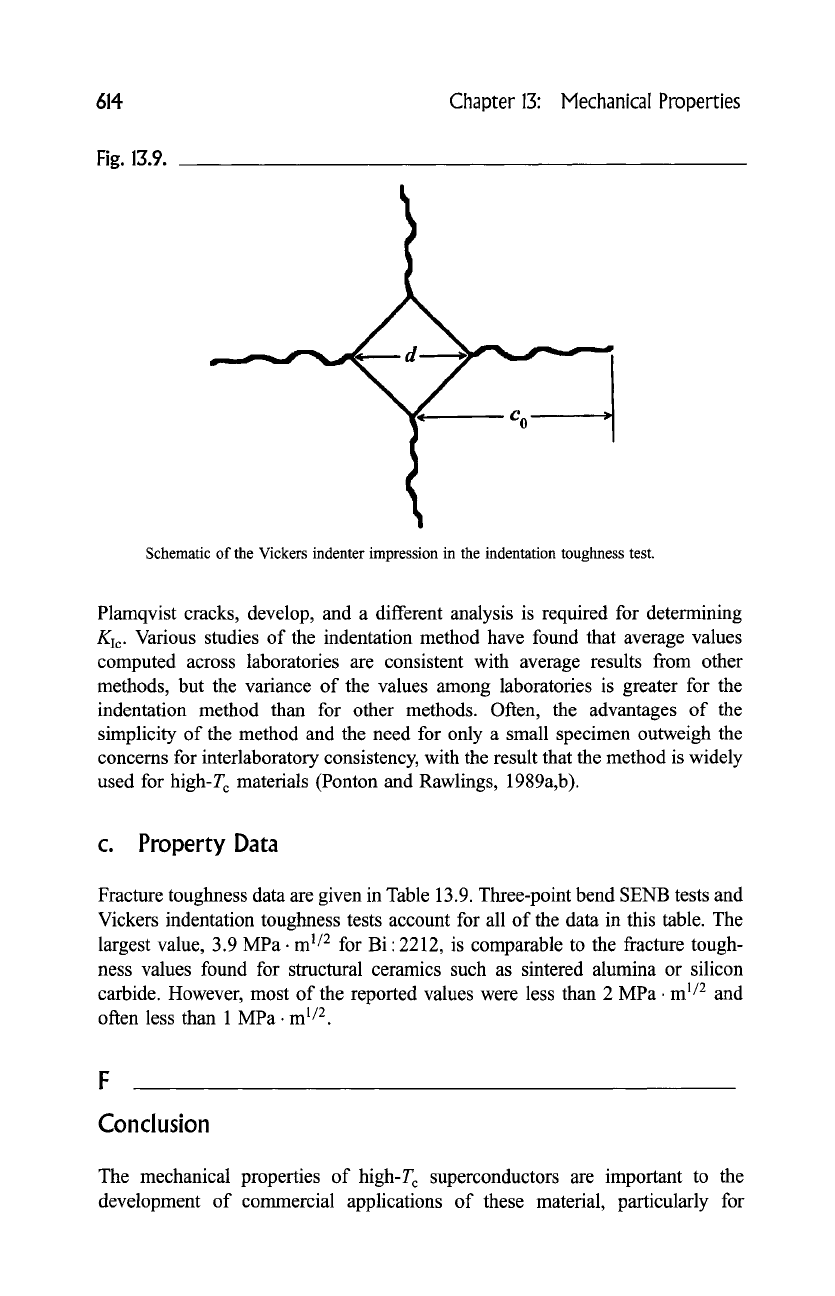
614 Chapter
13:
Mechanical Properties
Fig. 13.9.
_
Schematic of the Vickers indenter impression in the indentation toughness test.
Plamqvist cracks, develop, and a different analysis is required for determining
Kic. Various studies of the indentation method have found that average values
computed across laboratories are consistent with average results from other
methods, but the variance of the values among laboratories is greater for the
indentation method than for other methods. Often, the advantages of the
simplicity of the method and the need for only a small specimen outweigh the
concerns for interlaboratory consistency, with the result that the method is widely
used for high-T c materials (Ponton and Rawlings, 1989a,b).
c. Property Data
Fracture toughness data are given in Table 13.9. Three-point bend SENB tests and
Vickers indentation toughness tests account for all of the data in this table. The
largest value, 3.9 MPa. m 1/2 for Bi:2212, is comparable to the fracture tough-
ness values found for structural ceramics such as sintered alumina or silicon
carbide. However, most of the reported values were less than 2 MPa. m 1/2 and
often less than 1 MPa-m 1/2.
Conclusion
The mechanical properties of high-T c superconductors are important to the
development of commercial applications of these material, particularly for
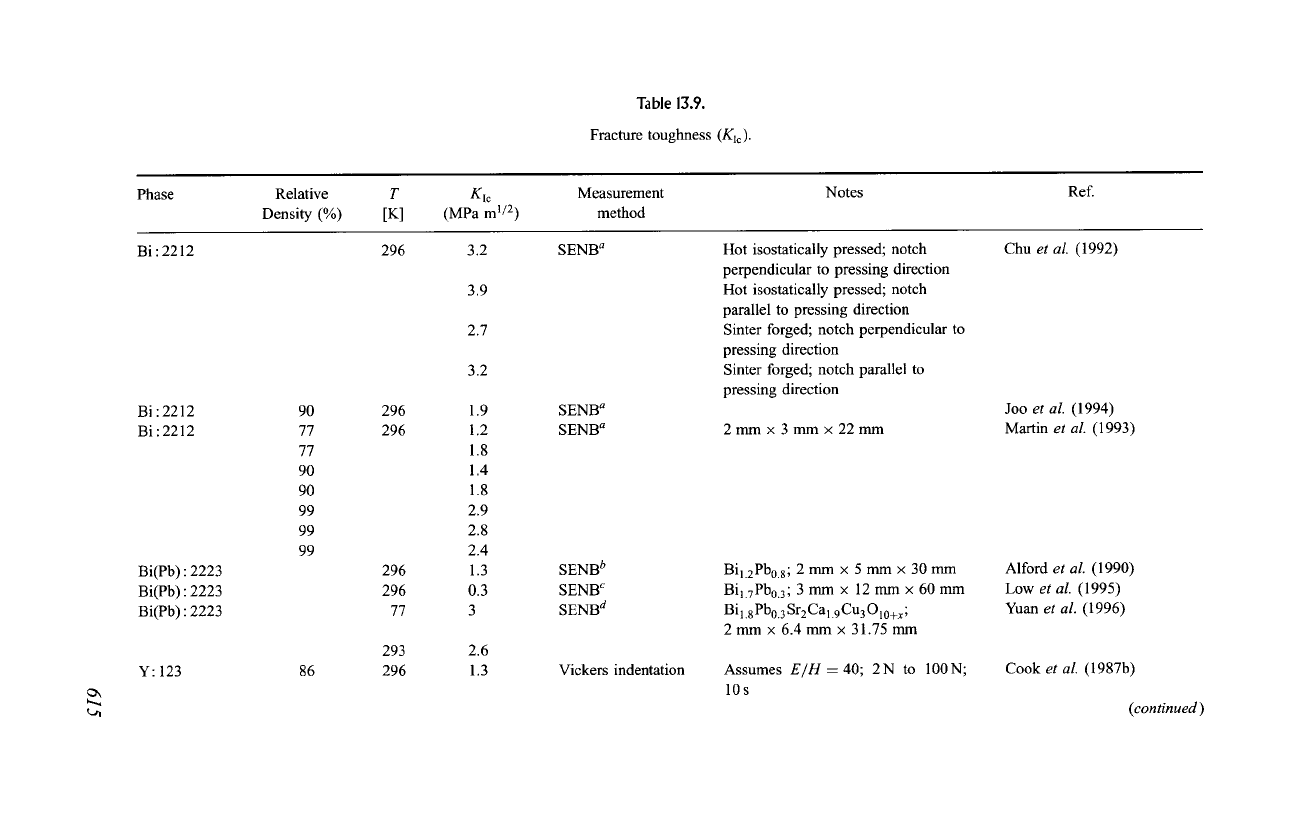
Table
13.9.
Fracture toughness (Kic).
Phase
Relative
Density (%)
T
[K]
Kic
(MPa m 1/2)
Measurement
method
Notes
Ref.
o,,
t.~
Bi:2212
Bi:2212
Bi:2212
Bi(Pb) : 2223
Bi(Pb) : 2223
Bi(Pb) : 2223
Y: 123
90
77
77
90
90
99
99
99
86
296
296
296
296
296
77
293
296
3.2
3.9
2.7
3.2
1.9
1.2
1.8
1.4
1.8
2.9
2.8
2.4
1.3
0.3
3
2.6
1.3
SENB a
SENB a
SENB a
SENB b
SENB c
SENB d
Vickers indentation
Hot isostatically pressed; notch
perpendicular to pressing direction
Hot isostatically pressed; notch
parallel to pressing direction
Sinter forged; notch perpendicular to
pressing direction
Sinter forged; notch parallel to
pressing direction
2mm x 3 mm x 22mm
Bil.2Pb0.8; 2 mm • 5 mm • 30 mm
Bil.7Pb0.3; 3 mm x 12 mm x 60 mm
B i 1.8 Pb0.3 Sr 2 Ca 1.9 Cu3010+x;
2 mm x 6.4 mm x 31.75 mm
Assumes
E/H -- 40; 2 N to 100 N;
10s
Chu
et al. (1992)
Joo
et aL (1994)
Martin
et aL (1993)
Alford
et al. (1990)
Low
et aL (1995)
Yuan
et al. (1996)
Cook
et aL (1987b)
(continued)
